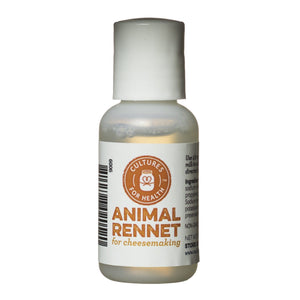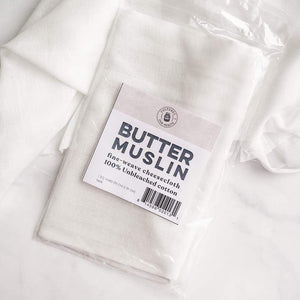
Edam is a mild cheese that is typically formed into a round (boule) rather than being pressed. It improves with age and is a great accompaniment to fruits.
5 minutes
4 hours
1 Wheel
INGREDIENTS AND EQUIPMENT AVAILABLE AT CULTURES FOR HEALTH
Mesophilic Direct-Set Starter Culture MA4001
Annatto Cheese Coloring
Liquid Animal Rennet

Liquid Animal Rennet
$9.49
High quality single strength animal rennet. This non-GMO animal rennet is preferred for aged cheese as it creates a more desirable flavor and aroma during the aging process. Each bottle contains enough rennet to set (12) 2-gallon batches of cheese.
Liquid Vegetable Rennet

Liquid Vegetable Rennet
$5.99
Double-strength liquid vegetable rennet. Each bottle contains enough rennet to set (24) 2-gallon batches of cheese.
Organic Vegetable Rennet
Cheese Salt

Pocket Test Thermometer
Butter Muslin

Butter Muslin
$5.99
Butter Muslin is a tightly woven cloth, similar to cheesecloth, used for draining, pressing, and straining soft cheeses, yogurt or milk kefir. Butter muslin cloth also works as a breathable jar cover for all sorts of fermenting applications.
INGREDIENTS:
- 2 gallons skim milk
- 2 packets of mesophilic starter culture or 1/4 tsp. bulk mesophilic starter
- 1 tsp. cheese coloring diluted in 1/3 cup cool water
- 1/2 tsp. liquid rennet diluted in 1/4 cup cool water
- Cheese salt
INSTRUCTIONS:
- Heat the milk slowly over low heat to 88°F. Turn off the heat.
- Stir in the starter thoroughly. Cover and maintain the temperature at 88°F for 30 minutes. Leave the milk undisturbed for the duration of the ripening period.
- Add the diluted cheese coloring, using a whisk to incorporate thoroughly.
- Add the rennet, pouring it through a perforated spoon into the milk then stirring for a full minute, using slow up-and-down motions, right down to the bottom of the pot. Cover and let it set for 30-45 minutes, maintaining the temperature at 88°F.
- Once you have a clean break between curds and whey, cut the curds into 1/2-inch pieces and let them rest for 5 minutes.
- Begin to slowly raise the temperature to 92°F, stirring gently but often to keep curds from sticking together (matting). The curds will begin to shrink and become firmer. Once 92°F has been reached, turn off the heat and let the curds sit, uncovered and undisturbed, for 30 minutes.
- The curds will have sunk to the bottom. Ladle whey off until you can see the curds sitting on the bottom. Save the whey. Stir the curds for 20 minutes, or until they begin to mat and cling together. Add hot water to the pot until the curds and whey come up to 99°F, and then keep them at that temperature for 20 minutes. The curds should settle again.
- Line a colander with clean, damp butter muslin and suspend it over a large bowl. Ladle the curds into it. Let the curds drain in the colander for 5 minutes. Toss in 1 Tbsp. of cheese salt.
- Divide the curds evenly into two portions, tying up each portion into a draining sack of its own. Use clean hands to shape the curds within the draining sack into a ball shape. Let them hang for 30 minutes to drain thoroughly.
- Place the saved whey back into the pot and heat it to 122°F. Remove from heat. Take the boules out of the draining sacks and submerge them in the warmed whey for 20 minutes, taking care to maintain the temperature. Turn the cheeses a few times within the whey. Re-dress the cheeses into their cloth draining sacks and hang them up to drain again for 6 hours.
- Prepare 2 quarts of medium brine (26-ounces of salt to 1 gallon of water), and chill it to 50°F. Remove the cheeses from their cloth sacks and submerge them in the brine. Put a cover over the container of brine and cheese and refrigerate overnight.
- Take the boules out of the brine and pat them dry with a paper towel. Put them on a cheese mat and allow them to air-dry for 1-2 days.
-
Wax the cheese. Ripen at 55°F and 85% humidity for 2 to 3 months. Flip the cheese repeatedly during the aging process. The cheese can be aged up to 6 months for a fuller, more developed flavor.
















